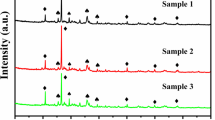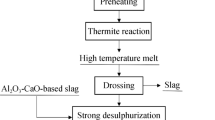Abstract
In this study, a novel process for recovering Cr from Cr-bearing electroplating sludge (ES) was proposed, which involved the desulfurization stage and reduction-smelting stage. In the desulfurization stage, the decomposition of CaSO4 in the ES was promoted by adding a certain amount of carbon. It was found that the desulfurization ratio increased first and then decreased as increasing the C/S (molar ratio) from 0.5 to 2, while it monotonously increased as the temperature was raised. The product with the highest desulfurization ratio (89.71%) and the lowest residual sulfur of ES (0.47 wt%) was obtained when the reaction temperature was 1100 ℃ and C/S was 1.5. The desulfurized ES was then deeply reduced by Si. In this stage, Si reduced Cr2O3 in the ES to metallic Cr and formed a liquid Fe–Cr–Si alloy (ferrosilicochromium). The ferrosilicochromium was separated from the molten slag by gravity, and the recovery ratios of Fe and Cr reached 98.9% and 98.7%, respectively. The carbon and sulfur contents of the prepared ferrosilicochromium were 0.01 and 0.009 wt%, respectively, which reached the requirement of commercial ferrosilicochromium (C ≤ 0.02 wt%, S ≤ 0.01 wt%). In addition, SiO2 produced from the silicothermic reduction facilitated the vitrification of slag, and the harmless glassy slag was finally obtained.
Graphical Abstract











Similar content being viewed by others
Data availability
All data included in this study are available upon request by contacting with the corresponding author.
References
Yu Y, Wang H, Hu JH (2021) Co-treatment of electroplating sludge, copper slag, and spent cathode carbon for recovering and solidifying heavy metals. J Hazard Mater 417:126020. https://doi.org/10.1016/j.jhazmat.2021.126020
Li CT, Lee WJ, Lee EJ, Huang KL, Fu SF, Lai YC (2007) Vitrification of chromium electroplating sludge. Environ Sci Technol 41:2950–2956. https://doi.org/10.1021/es062803d
Mao L, Guo H, Zhang W (2018) Addition of waste glass for improving the immobilization of heavy metals during the use of electroplating sludge in the production of clay bricks. Constr Build Mater 163:875–879. https://doi.org/10.1016/j.conbuildmat.2017.12.177
Li NH, Lo SL, Hu CY, Hsieh CH, Chen CL (2011) Stabilization and phase transformation of CuFe2O4 sintered from simulated copper-laden sludge. J Hazard Mater 190(1–3):597–603. https://doi.org/10.1016/j.jhazmat.2011.03.089
Li M, Su P, Guo Y, Zhang W, Mao L (2017) Effects of SiO2, Al2O3 and Fe2O3 on leachability of Zn, Cu and Cr in ceramics incorporated with electroplating sludge. J Environ Chem Eng 5(4):3143–3150. https://doi.org/10.1016/j.jece.2017.06.019
Yan K, Liu Z, Li Z, Yue R, Guo F, Xu Z (2019) Selective separation of chromium from sulphuric acid leaching solutions of mixed electroplating sludge using phosphate precipitation. Hydrometallurgy 186:42–49. https://doi.org/10.1016/j.hydromet.2019.03.013
Li C, Xie F, Ma Y, Cai T, Li H, Huang Z et al (2010) Multiple heavy metals extraction and recovery from hazardous electroplating sludge waste via ultrasonically enhanced two-stage acid leaching. J Hazard Mater 178(1–3):823–833. https://doi.org/10.1016/j.jhazmat.2010.02.013
Souza ESPT, Mello NT, Menezes Duarte MM, Montenegro MC, Araujo AN, Barros Neto B et al (2006) Extraction and recovery of chromium from electroplating sludge. J Hazard Mater 128(1):39–43. https://doi.org/10.1016/j.jhazmat.2005.07.026
Xiao Y, Li L, Huang M, Liu Y, Xu J, Xu Z et al (2022) Treating waste with waste: metals recovery from electroplating sludge using spent cathode carbon combustion dust and copper refining slag. Sci Total Environ 838(Pt 3):156453. https://doi.org/10.1016/j.scitotenv.2022.156453
Huang R, Huang KL, Lin ZY, Wang JW, Lin C, Kuo YM (2013) Recovery of valuable metals from electroplating sludge with reducing additives via vitrification. J Environ Manag 129:586–592. https://doi.org/10.1016/j.jenvman.2013.08.019
Chou IC, Kuo YM, Lin C, Wang JW, Wang CT (2012) Electroplating sludge metal recovering with vitrification using mineral powder additive. Resour Conserv Recycl 58:45–49. https://doi.org/10.1016/j.resconrec.2011.10.006
Chen H, Yuan H, Mao L, Hashmi MZ, Xu F, Tang X (2020) Stabilization/solidification of chromium-bearing electroplating sludge with alkali-activated slag binders. Chemosphere 240:124885. https://doi.org/10.1016/j.chemosphere.2019.124885
Wilde BE, Armijo JS (1966) Influence of sulfur on the corrosion resistance of austenitic stainless steel. Corrosion 23(7):208–214. https://doi.org/10.5006/0010-9312-23.7.208
Mihara N, Kuchar D, Kojima Y, Matsuda H (2007) Reductive decomposition of waste gypsum with SiO2, Al2O3, and Fe2O3 additives. J Mater Cycles Waste Manag 9(1):21–26. https://doi.org/10.1007/s10163-006-0167-4
Higuchi K, Gushima A, Ikeda T (2016) Synthesis of calcium ferrite from waste gypsum board. ISIJ Int 56(1):168–175. https://doi.org/10.2355/isijinternational.ISIJINT-2015-317
Wang HY, Hou Y, Zhang GH, Chou KC (2020) Effect of Si on desulfurization in Fe–Si–S, Fe–Si–Cr–S and Fe–Si–Ni–S Melts. ISIJ Int 60(4):636–639. https://doi.org/10.2355/isijinternational.ISIJINT-2019-453
Wang HY, Zhang GH, Chou KC (2020) Preparation of low-carbon and low-sulfur Fe-Cr-Ni-Si alloy by using CaSO4-containing stainless steel pickling sludge. Metall Mater Trans B 51(5):2057–2067. https://doi.org/10.1007/s11663-020-01922-9
Gasik M (2013) Technology of chromium and its ferroalloys. Handbook of ferroalloys. Elsevier Ltd, Oxford, pp 267–316
Zhang GH, Chou KC (2012) Measuring and modeling viscosity of CaO-Al2O3-SiO2(-K2O) melt. Metall Mater Trans B 43(4):841–848. https://doi.org/10.1007/s11663-012-9668-9
Liu XC, Li YJ, Zhang N (2002) Influence of MgO on the formation of Ca3SiO5 and 3CaO·3Al2O3·CaSO4 minerals in alite–sulphoaluminate cement. Cem Concr Res 32(7):1125–1129. https://doi.org/10.1016/S0008-8846(02)00751-2
Gasik M (2013) Ferrosilicon and silicon technology. Handbook of ferroalloys. Elsevier Ltd, Oxford, pp 179–220
Yu HX, Wang XH, Wang M, Wang WJ (2014) Desulfurization ability of refining slag with medium basicity. Int J Miner Metall Mater 21(12):1160–1166. https://doi.org/10.1007/s12613-014-1023-5
Fruehan RJ, Turkdogan ET (1971) Desulfurization of iron alloys in vacuo-free energy of formation of SiS (v). Metall Trans 2:895–902. https://doi.org/10.1007/BF02662752
Fruehan RJ (1977) Desulfurization of liquid steel containing aluminum or silicon with lime. Metall Trans 9B:287–292. https://doi.org/10.1007/BF02653694
Maweja K, Mukongo T, Mutombo I (2009) Cleaning of a copper matte smelting slag from a water-jacket furnace by direct reduction of heavy metals. J Hazard Mater 164(2–3):856–862. https://doi.org/10.1016/j.jhazmat.2008.08.107
Acknowledgements
This work was financially supported by the State Key Laboratory of Advanced Metallurgy, University of Science and Technology Beijing, China.
Author information
Authors and Affiliations
Corresponding author
Ethics declarations
Conflict of interest
On behalf of all authors, the corresponding author states that there is no conflict of interest.
Additional information
The contributing editor for this article was Il Sohn.
Publisher's Note
Springer Nature remains neutral with regard to jurisdictional claims in published maps and institutional affiliations.
Rights and permissions
Springer Nature or its licensor (e.g. a society or other partner) holds exclusive rights to this article under a publishing agreement with the author(s) or other rightsholder(s); author self-archiving of the accepted manuscript version of this article is solely governed by the terms of such publishing agreement and applicable law.
About this article
Cite this article
Wang, HY., Jiao, SQ. & Zhang, GH. Preparation of Ferrosilicochromium by Silicothermic Reduction of Cr-Bearing Electroplating Sludge. J. Sustain. Metall. 9, 303–313 (2023). https://doi.org/10.1007/s40831-023-00651-y
Received:
Accepted:
Published:
Issue Date:
DOI: https://doi.org/10.1007/s40831-023-00651-y




